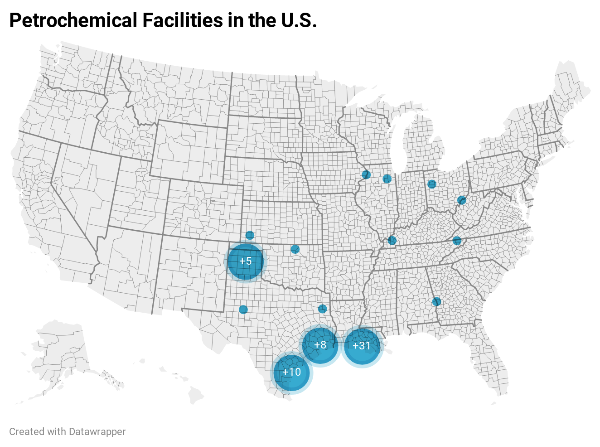Last year, Louisiana joined a growing list of states that pledged to reach net-zero greenhouse gas emissions (GHG) by 2050. Given the state is the fourth largest GHG emitter in the U.S. achieving midcentury emission reduction targets will be especially challenging for Louisiana. Emissions from heavy industry, mostly from chemical manufacturing facilities and oil refineries, account for over half of Louisiana’s total GHG total emissions. Further complicating the state’s recent decarbonization goal is the fact that Louisiana has approved a slew of new industrial facilities that will significantly increase its GHG emissions footprint over the next decade.
Research from the University of Texas, Austin and Resources for the Future estimates potential GHG emissions from industrial facilities and infrastructure projects recently constructed, or soon to be built, in the Gulf region, specifically Texas and Louisiana. The researchers found that these facilities could raise annual GHG emissions by over 500 million tons in the next decade, which is more than 8 percent of the current annual U.S. total. Nearly 40 percent of the forecasted GHG emissions associated with this infrastructure buildout will come from petrochemical developments. If these facilities are constructed with no effort to abate any of their emissions, as the researchers assume, it would be nearly impossible for Louisiana, or the United States for that matter, to meet its decarbonization goals. Rather than building more of the same, Gulf states like Louisiana and Texas can be a model for having a vibrant industrial sector while still slashing emissions over the next decade.
Both Louisiana and Texas have unique local characteristics that they can leverage to create opportunities to advance carbon capture and sequestration (CCS). This technology will be critical for decarbonizing heavy industry. For example, both states have abundant underground reservoirs which can be used to store carbon captured from industrial facilities. According to the Department of Energy’s Carbon Storage Atlas, Texas and Louisiana have the highest carbon storage capacity of all states in the continental U.S. Additionally, the Gulf Coast currently has the second largest network of CO2 pipelines in the U.S., which are already transporting carbon captured from industrial sources to enhanced oil recovery (EOR) sites in the region. The abundance of geologic storage sites and existing infrastructure to move captured CO2 around the region gives these Gulf states a comparative advantage in developing CCS technologies.
While the costs of applying CCS are still prohibitively high for many applications, the manufacturing of petrochemicals, ethanol, and natural gas processing all produce a pure stream of CO2. As such, applying CCS to these facilities is relatively cheap because the CO2 does not need to be separated from other gases. The image below depicts the number of petrochemical facilities across the U.S. The sheer number of petrochemical facilities in the Gulf Coast region is large enough to produce economies of scale with regards to CCS technology and help make this technology cheaper for subsequent applications.

While the federal government has an important role in incentivizing carbon capture and sequestration technology and currently does so through the 45Q tax credit, the individual state governments of Louisiana and Texas can take steps to help scale this technology. One practical step both states can take is to clear up regulatory barriers that govern CCS, specifically permitting CO2 sequestration. The current permitting structure for CO2 sequestration in wells is onerous, with CO2-EOR storage wells, permanent underground storage wells (which require a permit process from the EPA), and storage wells in state lands (including offshore/coastal areas) all requiring a separate permitting process. States can streamline permitting pathways by applying to take over this Class VI permitting process from the EPA. In 2017, EPA granted a state’s request for the first time by approving North Dakota’s request to enforce its own Class VI program, and later Wyoming was also given the go-ahead to enforce Class VI wells. States around the Gulf, primarily Texas and Louisiana, could follow suit to create the necessary regulatory environment to deploy CCS technology rapidly.
The Gulf states are uniquely situated to become the carbon capture capital of the U.S. and potentially the world. Their vast CO2 storage resources, abundance of facilities that produce a pure stream of CO2, and relatively robust network of CO2 pipelines provide an ideal environment for building a vibrant low-carbon industrial sector.